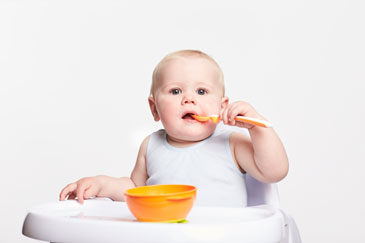The bottom line is that you can’t make your child eat – the more you try to make them eat, the more they will resist
5 fixes for messy meal times
- Limit mealtime to about 20 minutes. Your child is unlikely to eat for any longer. Similarly, enzymes don’t last forever, so limiting mealtime helps maximise their effectiveness.
- Set realistic goals for mealtime behaviour and don’t load your child’s plate with more than they usually eat. This can overwhelm them.
- Use the power of example. Show your own excitement about trying new foods and eating properly. Say things like, “I’ve never had this food before but I really like it”.
- Timing can be important. It’s best to offer food before your child is tired.
- Be patient. Bear in mind that toddlers may need to try new foods many times before they accept them.
Ignore the behaviours that interfere with eating, such as dawdling and complaining, to avoid unintentionally reinforcing these.
How to keep your cool
Young children respond to the strength of an emotion rather than the feeling behind it. Your strong frustration expressed to your child may be more rewarding to them than vague, uninterested praise.
So use positive emotion-rich language to praise good eating behaviour and be specific. For example, “Sam, smart idea to load your fork while you are chewing that other bite”.
PLAY VIDEO
Similarly, your child might repeat a behaviour that resulted in you yelling, perceiving your highly emotional response as a reward.
Ignore the behaviours that interfere with eating, such as dawdling and complaining, to avoid unintentionally reinforcing these
Make food interesting and fun
- Use choices rather than commands. Say, “It’s time for breakfast. Do you want pancakes or toast?” When shopping, let your child choose food they would like to try.
- Involve your toddler in meal planning – choosing recipes with photos, adding measured ingredients, and so on.
- Serve food in fun shapes or colours, or make a funny face with food. Add new flavours, such as peanut butter or tomato sauce.
- Start a rewards system – say, so many points towards dessert or stickers for each mouthful or quarter cup of peas.
Is it just ‘bad’ behaviour?
No, not always. If your child’s eating pattern has changed, it could be a medically based issue. There are several things that might cause decreased appetite or an upset stomach. These include acid reflux, sinus or lung infections, pancreatic insufficiency, food allergies and medications.
Teething can also affect appetite. If that’s the case, offer your child soft, cold foods such as smoothies and jelly.
Some people with CF find it difficult to eat breakfast before doing airway clearance in the morning.
Where can we get advice?
Discuss eating problems with your child’s CF team. They can help you determine whether there’s a medical or behavioural reason, and give you more tips on managing mealtimes.
Ask the psychology team to help you put a behavioural plan in place to make sure your child is eating properly.
Did you know?
Children commonly take five or six tries before they accept new foods.
Children and adults taste food in different ways; some flavours taste stronger and others blander. You can’t assume your child will like what you like.
Children prefer eating “pure” ingredients to combinations. For example, they’re more likely to eat meat, potatoes and a vegetable than a casserole combining all three.
Click on How CF Affects the Body to find out more about diet and CF.
Click on Getting Support to find helpful parenting sites and useful information.





